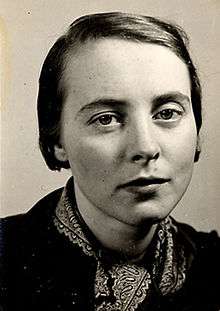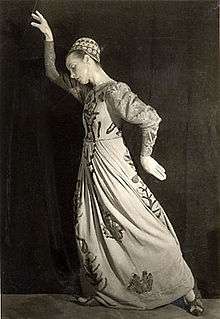Hanna Berger
| Hanna Berger | |
|---|---|
 Hanna Berger, German Dance Archive Cologne | |
| Born |
Johanna Elisabeth Hochleitner-Köllchen 23 August 1910 Vienna, Austro-Hungarian Empire |
| Died |
15 January 1962 (aged 51) East Berlin, East Germany |
| Nationality | Austrian |
| Known for | Dance, choreography and film directing |
| Movement | Modern dance |
Hanna Berger (born Johanna Elisabeth Hochleitner-Köllchen; 23 August 1910 in Vienna; died 15 January 1962 in East Berlin) was an Austrian dancer, choreographer, teacher, director, theatre director, writer and lifelong anti-Nazi.
Life and work

Hanna Berger grew up in the working class district of Meidling. From age 14 she received piano lessons. From 1927 to 1928 she became a member of the Communist Party. From 1929 to 1934 she studied modern dance in Berlin along with Jonny Ahemm, Vera Skoronel, Gertrud Wienecke and Mary Wigman in Dresden; she has also been described as part of the free dance movement.[1] During this time, her relationship with sculptor Fritz Cremer began, which lasted until the 1950s.
Artistic career
Berger was recorded as a member of the touring company of Mary Wigman in 1935, and that of Trudi Schoop in 1936 for her US tour. She added her knowledge of modern dance to the "German champion centres for dance" in Berlin. In October 1937 she made her evening debut as a choreographer and dancer as part of an eleven-part solo at the Berlin Bach-Saal. At the critical time of her solo "Warrior" (with music by Kessler) she was forced to flee from Nazi Germany. She was a known critic of the fascist dictatorship. Until then she had only practiced in the Swiss magazine under the pseudonym "The Stage Artist" (1936).
Her Vienna debut took place in December 1937 at the great hall of the Urania. Berger was an active member of the communist resistance and a part of the Red Orchestra/Schulze-Boysen-Gruppe group, with extensive activities in Italy. In 1942 she was arrested in Poznan due to "suspicion to commit high treason". She was blamed for "enabling subversive communist gatherings in her home". Presumed innocent after the intercession of many prominent personalities, including the dancer Marianne Vogelsang, Berger was acquitted after several months of detention on 22 August 1943 by the People's Court in Berlin. She was sentenced to two years forced labour; in 1943 she was able to escape due to the bombing in Berlin. Despite her injuries she was able to travel to Vienna.
After the war she worked as a dance critic and a dancing and film screenplay author. She performed at the Vienna Theatre and in Paris. She also taught modern dance at the University of Music and Performing Arts. Until 1950 she headed the private "Vienna Children's Theatre", of which the following names have become known, such as Christine Ostermayer, Klaus Löwitsch and Gerhard Senft. The dancing solos "solidarity" (Eisler/Brecht) and "Battle Cry" were some of Berger's strengths.
With the founding of the GDR led to Berger's decision to emigrate there. In 1956 she took over the movement director of Janáček's opera "The Cunning Little Vixen", directed by Walter Felsenstein. Her efforts to be firmly ordered as a director under Felsenstein ended in failure. Until her ultimate death she commuted between Vienna, Paris, Italy, the GDR and other socialist countries with no permanent home or residence. Her communist convictions remained an obstacle to her greater career. In the GDR performers could not express their artistic personality, because it was a little too dogmatic.
After Fritz Cremer, the Viennese Paul Kont was her life partner. With him she founded the Vienna Chamber Dance Group in or around 1954.[2] He also wrote the music to three dance pieces, among other things, including "Dance ads" by Schoop in 1956 and "The sad hunter" and "Amores Pastorals" in 1958, which was choreographed and put on Austrian television. By studying film design at the Vienna Music Academy from 1955 to 1957 she hoped until recently on a new career as a filmmaker. On behalf of the City of Vienna she was able to study with Marcel Marceau in Paris. As one of the first of his students she earned a teaching diploma. She also performed work by Grete Wiesenthal.
Hanna Berger died on 15 January 1962 at the East Berlin Charité Hospital. She is buried in a grave of honour in the City of Vienna.
Reception
In the Vienna Urania on 5 January 1958 Berger officially announced her dancers to a new generation. The dancer and ballet teacher Mitterhuber received the solo "Unknown from the Seine" (Debussy). She had studied at the dance department of the University of Music and Performing Arts, Vienna from 1947–1957, and was also featured in the Berger Dance program in 1958. With the new production of this solo, which has since been danced by dancer Esther Koller, Vienna has begun rediscovering the visionary Berger (among other things she has proposed the creation of a dance stage and dance film museum).
As part of the production "Dances of outlaws" of Esther Linley, in 1995 this solo was a central role at the Linzer Posthof. In 2000 Mitterhuber reconstructed the Berger solo "mimosa" (Casella) again danced by Esther Koller. The exhibition program "Dance in exile" was curated by Andrea Amort at the Vienna Academy Theatre during the festival tanz2000.at & ImPulsTanz.[3]
The program "Hanna Berger: Retouchings” was curated in 2006 by Andrea Amort at the Festspielhaus St Pölten. Fragmentary works by Berger were choreographed as new creations by Nicholas Adler, Manfred Aichinger, Bernd Roger Bienert, Rose Breuss and Willi Dorner. The program was shown at festivals in Washington, Braunschweig and Vienna. Esther Koller danced "L'Inconnue de la Seine"in the 2011 opening of an exhibition for the achievements of women teaching at the University of Music and Performing Arts, Vienna.
References
- ↑ Deborah Holmes; Lisa Silverman (2009). Interwar Vienna: Culture Between Tradition and Modernity. Camden House. pp. 133–4. ISBN 978-1-57113-420-2.
- ↑ Bettina Vernon; Charles Warren (1999). Gertrud Bodenwieser and Vienna's Contribution to Ausdruckstanz. Psychology Press. p. 150. ISBN 978-90-5755-035-5.
- ↑ "Dance in Exile : Central European Expressionist Dance". www.impulstanz.com. 2000. Retrieved 2016-01-25.
- Andrea Amort, Mimi Wunderer-Gosch (Hrsg.): Österreich tanzt. Geschichte und Gegenwart. Böhlau Verlag, Wien/ Köln/ Weimar 2001, ISBN 3-205-99226-1.
- Andrea Amort: Free Dance in Interwar Vienna. In: Deborah Holmes, Lisa Silverman (Hrsg.): Interwar Vienna. Culture between Tradition and Modernity. Camden House, New York 2009, ISBN 978-1-57113-420-2, S. 117–142.
- Andrea Amort: Hanna Berger. Spuren einer Tänzerin im Widerstand. Christian Brandstätter Verlag, Wien 2010, ISBN 978-3-85033-188-3.
- Geertje Andresen: Hanna Berger. In: Die Tänzerin, Bildhauerin, Nazigegnerin Oda Schottmüller 1905–1943. Lukas Verlag, Berlin 2005, ISBN 3-936872-58-9, S. 144 ff.
- Gisela Notz: Das Kämpferische Leben der Tänzerin Johanna (Hanna) Berger (1910–1962). In: Jahrbuch für Forschungen zur Geschichte der Arbeiterbewegung. Heft III/2012.
External links
- Cultural Foundation
- Touches – in search of a lost time at the Wayback Machine (archived 8 July 2007) at www.tanz.at
- partial reduction in the German Dance Archive in Cologne
- portrait of the dancer Hanna Berger, Fritz Cremer